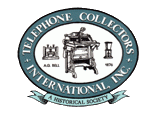
Telephone Collectors International
The Bookshelf
Last update May 14, 2015
 | Telephone Collectors InternationalThe Bookshelf | First Posted Aug 22, 1999 Last update May 14, 2015 |
from the December 1998 issue of Singing Wires Journal newsletter
by George Howard
This month I am continuing a review of George Bartlett Prescott's series on the telephone. Prescott was born in 1831. In 1860 he published an important book on telegraphy. He was an inventor of electrical devices, and by 1874 had applied for a patent with Thomas A. Edison on a duplex telegraph instrument. In 1876 he brought a complaint against Z. F. Wilber, the patent office clerk who processed A. Graham Bell's patent application for the telephone. By this time Prescott was a vice-president of Western Union. and in that capacity was involved in the negotiation of the agreement with the Bell Telephone Co. to settle its patent suit against WU, resulting in the agreement of November 10, 1879. He continued to author numerous books on electrical subjects. He died in 1894. Last Month I reviewed his first book on telephony, published in 1878, titled The Speaking Telephone, Talking Phonograph and Other Novelties.
In 1879 Prescott's second book came out titled The Speaking Telephone, Electric Light, and Other Recent Inventions (New York: D. Appleton & Co.). A careful comparison of the first book with the second book shows that the second page of the preface in the newer book contains a larger text. The 428 pages following are exactly the same in both books. The author added three chapters on the end of the original book to create the new book which has 612 pages plus index. Included in the three additional chapters is one on Edison's recent inventions in telephony. There you will find a thorough discussion of Edison's work together with very fine engravings of his transmitter and the entire telephone instrument known as the Edison telephone. This is shown in several forms, made for the American Speaking Telephone Co. It utilized Edison's carbon transmitter and Phelps's double crown receiver. It is interesting to see that the indices in the two books are alike, except in the later book one page is inserted to include additional references to the electric light and Edison's Inventions. This second book is rare, and last sold in 1996 for $185.00. Today, it would be worth over $225.00.
In 1884 Prescott's third book was published, titled Bell's Speaking Telephone: It's Invention, Construction, Application, Modification and History(New York: D. Appleton & Co.). At first blush one would think that this book is entirely new, not just a rehash of his first and second books. But looks can be deceiving. A careful comparison of the 1879 and 1884 books reveals major similarities. Chapters on electrical topics other than the telephone and the phonograph have been omitted by 1884. The other chapters previously published have been renumbered and rearranged, three new chapters have been added at the end: the telephone exchange, various modifications of the Bell Telephone, and a history of the invention of the Edison speaking telephone.
Prescott's history of the invention unlike his previous two books, is now informed by the results of the litigation which exposed a number of claims to the invention of the telephone. (Not all claims were adjudicated, e.g. Antonio Meucci.) This history is very thorough, scholarly, authoritative, and illustrated in many engravings. He now concludes that A. Graham Bell invented the telephone. The author does not make clear what relation he had with Western Union at the time he wrote the third book. Western Union had an interest in upholding Bell's patent by this time, since it received royalties from Bell's invention. He does relate how Western Union came to agreement with the Bell organization in November 1879, and his first hand account is very revealing. While Bell invented the phone, Western Union held the patent on the induction coil which Bell was using without permission. These mutual patent infringements paved the way to agreement.
By 1884 switching of telephone calls had made the telephone commercially useful, Prescott includes a chapter on telephone switches which, owing to its early date, beautiful engravings, and scholarly explanation is very important. He now includes more engravings of Bell-related equipment which were scarce in his earlier works.
The third book was reprinted by the Arno Press in 1972 and four years ago this reprint sold for $45.00. 1 have an original copy which is exceedingly rare, and six years ago sold for $265.00. Today it is worth in the range of $350.00.
In 1890 Prescott's fourth book on the telephone was published, titled The Electric Telephone (New York: D. Appleton & Co.). The first 470 pages are the same as found in the 1884 book. Thereafter, Prescott omits the remainder of the patent litigation discussion, and adds a dozen more chapters to the book, increasing the total pages from 524 to 790. The additional chapters reflect the advances in the technology, including switching and long distance telephony. I found particularly interesting the chapter on the Cortlandt Street exchange in New York with its impressive engravings showing how the early multiple switchboard appeared and works.
The fourth book is exceedingly rare, and last sold in 1996 for $295.00. Today it is worth in the range of $325.00.